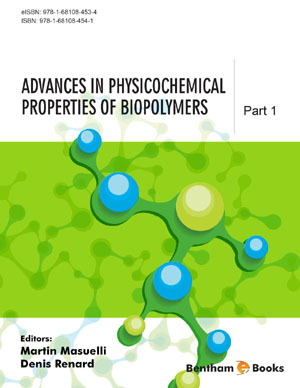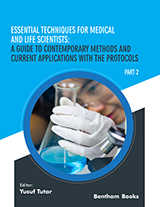Glucose and Lipid Metabolism
Page: 1-21 (21)
Author: Leszek Szablewski
DOI: 10.2174/978160805189211101010001
PDF Price: $30
Abstract
Glucose is an essential metabolic substrate of all mammalian cells. D-glucose is the major carbohydrate presented to the cell for energy production and many other anabolic requirements. Under normal physiological conditions, it is the sole source energy for the brain. Glucose is obtained directly from the diet. Dietary carbohydrates from which humans gain energy enter the body in different forms, such as monosaccharides, disaccharides, and polysaccharides and more so, also by the synthesis of other substrates in organs such as the liver. Glucose and other monosaccharides are transported across the intestinal wall to the hepatic portal vein and then to liver cells and other tissues. There they are converted to fatty acids, amino acids and glycogen (the liver stores excess glucose as glycogen and little glucose is normally converted to fat), or are oxidized by the various catabolic pathways of cells. In the first rate-determining step of metabolism, glucose is transported across the plasma membrane by the facilitative glucose transporters. Hexokinase then phosphorylates glucose to glucoso-6-phosphate. The product generally enters the glycolytic pathway, generating NADH, ATP, and pyruvate, or the pentose phosphate pathway. In the presence of sufficient oxygen, pyruvate can be fed into mitochondria and fully oxidized to produce more ATP. When oxygen is limited, pyruvate is disposed in the form of lactate and glycolysis becomes the main source for ATP production. Pentose phosphate pathway plays an important role in the synthesis of pentose sugars for DNA and RNA, as well as generation of NADPH for the synthesis of lipids.
Glucose Transporters
Page: 22-45 (24)
Author: Leszek Szablewski
DOI: 10.2174/978160805189211101010022
PDF Price: $30
Abstract
Glucose is obtained directly from the diet, principally following the hydrolysis of ingested disaccharides and polysaccharides, and by the synthesis from other substrates in organs such as the liver. Glucose derived from the diet is transferred from the lumen of the small intestine, and both dietary glucose and glucose synthesized within the body have to be transported from the circulation into target cells. These processes involve the transfer of glucose across plasma membranes. Because for its hydrophilicity, glucose cannot penetrate the lipid bilayer, and specific carrier proteins are required to its diffusion. These transporters comprise two structurally and functionally distinct groups, whose members have been identified over the past two decades, namely: the Na+-dependent glucose co-transporters (SGLT, members of a larger family of Na+-dependent transporters, gene name SLC5A) and the facilitative Na+-independent sugar transporters (GLUT family, gene name SLC2A). The number of known glucose transporters has expanded considerably over the past few years. These various transporters exhibit different substrate specificities, kinetic properties and tissue expression profiles. The number of distinct genes products, together with the presence of several different transporters in certain tissues and cell, indicates that glucose delivery into cells is a process of considerable complexity.
Glucose Homeostasis
Page: 46-100 (55)
Author: Leszek Szablewski
DOI: 10.2174/978160805189211101010046
PDF Price: $30
Abstract
Glucose is the main and preferred source of energy for the body. Poly- and oligosaccharides contained in foods are broken down into glucose. The liver and kidney also make glucose in the process of gluconeogenesis. In order to ensure the euglycemia necessary for metabolic processes in the cells glucose levels are carefully regulated to around 90 mg/dL (5 mM). The process of maintaining blood glucose at a steady-state level is called glucose homeostasis. This maintenance is achieved through a balance of several factors, including the rate of consumption and intestinal absorption of dietary carbohydrate, the rate of utilization of glucose by peripheral tissues and the loss of glucose through the kidney tubule, and the rate of removal or release of glucose by the liver. To avoid postprandial hyperglycemia (uncontrolled increases in blood glucose levels following meals) and fasting hypoglycemia (decreased in blood glucose levels during periods of fasting), the body can adjust glucose levels by a variety of cellular mechanisms. Important signals are conveyed by hormones, cytokines, and fuel substrates and are sensed through of cellular mechanisms. The liver plays a major role in blood glucose homeostasis by maintaining a balance between the uptake and storage of glucose via glycogenesis and the release of glucose via glycogenolysis and gluconeogenesis.
Insulin Resistance and Disturbance of Glucose Metabolism
Page: 101-174 (74)
Author: Leszek Szablewski
DOI: 10.2174/978160805189211101010101
PDF Price: $30
Abstract
Resistance and Disturbance of Glucose Metabolism
Insulin resistance is an early and major feature in the development of type 2 diabetes mellitus (noninsulin- dependent diabetes mellitus), but it is also associated with hyperlipidemia, hypertension, obesity, cardiovascular disease, nonalcoholic fatty liver disease, and various monogenic disorders such as Rabson- Mendenhall syndrome, leprechaunism, type A insulin resistance, and CFTDM syndrome (congenital muscle fiber type disproportion myopathy). Moreover, disturbances in sleep (sleep apnoea) and ovarian dysfunction are also characterized by insulin resistance. It is a major problem that is increasing rapidly worldwide. A number of factors increase the risk for insulin resistance, including genetic predisposition, obesity and inactivity, aging, medications, polycystic ovary syndrome, and rare disorders such as partial lipodystrophy. Diets high in saturated fats and carbohydrates are associated with glucose intolerance, obesity, coronary heart disease, and type 2 diabetes mellitus. Glucotoxicity, lipotoxicity, and glucolipotoxicity are secondary phenomena that are proposed to play a role in all forms of type 2 diabetes. Insulin resistance typically reflects multiple defects of insulin receptor and post-receptor signaling that impair a diverse range of metabolic and vascular actions.
Therapies and Emerging Targets for the Treatment of Diabetes
Page: 175-204 (30)
Author: Leszek Szablewski
DOI: 10.2174/978160805189211101010175
PDF Price: $30
Abstract
Current therapeutic approaches were largely developed in the absence of defined molecular targets or a solid understanding of disease pathogenesis. Within the past few years, our understanding of biochemical pathways related to the development of type 2 diabetes mellitus has expanded. The worldwide epidemic of type 2 diabetes has been stimulating the search for new concepts and targets for the treatment of this incurable disease. Studies using transgenic animals, gene transfer and pharmacological agents have yielded many data that have helped understand the molecular alterations characteristic of non-insulin dependent diabetes mellitus. This has opened the possibility for the development of potentially more-effective therapies, mainly focused on attenuating hepatic glucose production, enhancing glucose-dependent insulin secretion, enhancing the insulin signal transduction etc. Increasing knowledge on the biochemical and cellular alterations occurring in type 2 diabetes mellitus has led to the development of novel and potentially more effective therapeutic approaches to treat the disease.
Abstract
Full Text Avaliable
Introduction
Glucose homeostasis and insulin resistance presents a broad overview of the molecular, biochemical and clinical aspects of glucose metabolism and glucose resistance. The book serves to acquaint the reader with recent information on topics ranging from the glucose metabolism and glucose transporters, the hormonal regulation of glucose homeostasis, to insulin resistance and the characterization of novel pharmacological approaches on emerging targets for the treatment of diabetes. Also included in the book is a discussion on the role of mutations in insulin resistance. The book is particularly useful for clinical researchers, endocrinologists and diabetes specialists.

















